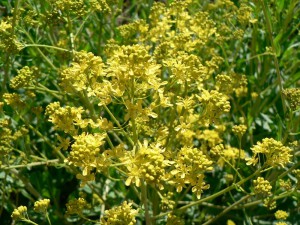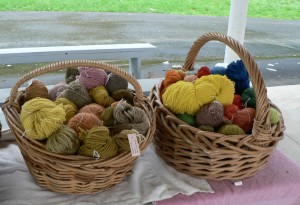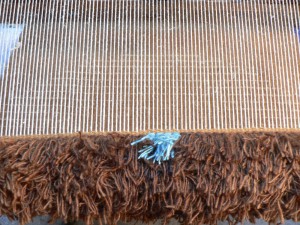This summer I started out with two small beds of woad on opposite sides of the garden. Normally I don’t grow woad in the same bed two years in a row because it doesn’t do well the second year. I know you ought to rotate beds to interrupt pest and disease life-cycles, and I thought we were doing pretty well with this considering that our garden isn’t that big. My woad has been plagued by slugs and cabbage whites, but I’ve never had serious disease before. I’ve always chalked-up the deficiencies of a second-year woad bed to a nutrient problem, though I’ve never actually tested “before” and “after” soil samples to find out exactly what gets depleted. So, my original two woad beds this year were not planted in the same beds as last year. Continue reading “Woad Gets Club Root”
Woad Blue Rya
I finished another rya! I wove it in record time between July 13-July 20. That was the week of our recent heat wave, which was grueling in every way. The one good thing about it was that, thanks to the heat, I spontaneously woke up at 5 each morning, and got busy weaving by 5:30. I wove a few rows before work, then wove a few more in the evenings, plus a couple marathons on the 13th and the 20th. Continue reading “Woad Blue Rya”
Orange Cosmos Rya
I finally finished this rya that I’ve had to un-weave and re-weave four times due to various problems and mistakes. The oranges and yellow-orange are dyed with orange cosmos. The brown is black walnut, and the blue at the center is dyed with woad. What looks like a solid orange block around the outside is actually two shades of orange, the darker blending into the lighter. Continue reading “Orange Cosmos Rya”
Saving Woad Seeds
Last summer I grew three beds of woad. This spring they all came up and bolted very happily.
Here is a close-up of a woad plant in bloom on May 4, 2013. You can see the family resemblance to broccoli, mustard, and other brassicas.
Here are two beds at peak bloom. Very fragrant! Even a little stinky! Continue reading “Saving Woad Seeds”
Massachusetts Sheep and Woolcraft Fair
This post falls into the category of better late than never. Over a month ago, now, I did a natural dyeing demo at the Massachusetts Sheep and Woolcraft Fair in Cummington, MA. It was a very rainy, windy and cold weekend. The high on Saturday was about 40. They were forecasting snow flurries for the hilltowns that night. Sunday was a bit better, with a high around 50, but still very rainy. Nevertheless, intrepid visitors showed up, and I had some great conversations with people about their favorite dyeplants (jewelweed and dahlias, which I have never tried) and their favorite ways of storing valuable dyebaths (in the freezer, which alas our freezer isn’t big enough to do).
I focused on dyeplants that can be found or grown here in Massachusetts. Here are the baskets with my samples of wool yarns.
The one on the right shows yarns dyed with cultivated plants (cosmos, woad, madder, weld, etc.). The basket on the left shows wildflowers (Queen Anne’s Lace, tansy, black walnut, umbilicate lichen, purple loosestrife, etc.). Continue reading “Massachusetts Sheep and Woolcraft Fair”
Flax is Up
Despite the enormous backlog of unprocessed flax under the bed, in the closet, and in the back of the car, I decided to plant more flax this year. I am growing Marilyn from the Hermitage. In my trials last year, Marilyn grew the tallest but also had the most trouble with lodging (flopping over and getting tangled on the ground). This year I am aiming for long, fine fiber. The little “line” I have managed to process thus far from years past is fairly coarse and stiff. I have always harvested around 90 days after planting, sometimes a bit later. My plan this year is to harvest much earlier than I have in the past, and then to compare the fiber with past crops. Continue reading “Flax is Up”
Too Short Warp
I have been running into quite a lot of problems with my ryas. Needless to say, this is frustrating and time-consuming. It is also stressful because I have a show at the Shelburne Arts Co-op, with Amanda Quinby, in October. I had envisioned a certain schedule to be ready for it, and I am now way behind schedule. Way. Continue reading “Too Short Warp”
Madder is Up
Spring has sprung here in our corner of Massachusetts, despite the sleet and hail yesterday. Today Matthew and I went to check on the madder at my dye and fiber plant garden at Bramble Hill Farm.
The madder has been there for three summers now. It likes the location, and has been spreading very nicely. After trying to keep it contained for the first couple years, I decided to double the width of the bed this season. So, today Matthew and I dug up the roots and shoots outside of the parameters of the new bed. Continue reading “Madder is Up”
Easter Egg
Today I wove the wood thrush’s “egg” part of my nest-like rya. The egg is dyed with woad and Queen Anne’s Lace. The nest is dyed with black walnut. The darkest shade of brown right around the egg is hand-spun naturally brown Romney singles combined with my darkest shade of black walnut. Romney is a breed of sheep. I bought a huge bittersweet chocolate colored fleece many years ago at the Webs Fleece Market, but alas I can’t remember who I bought it from.
Row one:
Nest Rya
Once again, thanks to a snow day on Tuesday, I have made more progress on my new rya this week than I might have otherwise. Nevertheless, it is posing many challenges. The design is supposed to resemble an egg in a nest (Matthew’s idea–Thanks, Matthew!). Specifically, I’m thinking of a wood thrush egg, which is a very beloved bird to me. My colors are shades of tan and brown, dyed with black walnut, and blue-green for the egg, dyed with Queen Anne’s Lace and woad. Wood thrushes like to incorporate white material into their nests, so there is a very light colored layer around the outside of my design. Continue reading “Nest Rya”




